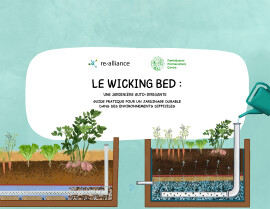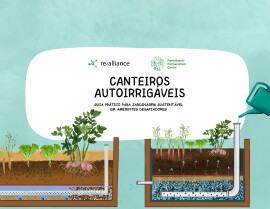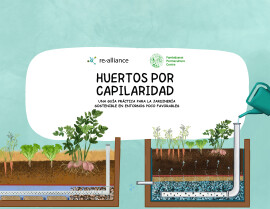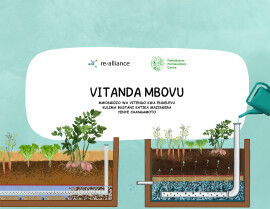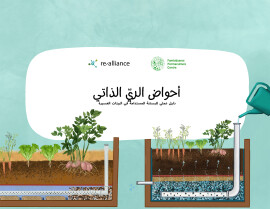
Looking after Our Land
'Desertification' is not the creation of a desert - or very rarely! It is a process of resource degradation. Helping people to acquire the tools, knowledge and confidence the need to reverse this process is one of the major challenges facing development workers in arid and semi-arid Africa. Soil conservation projects in sub-Saharan Africa have had a troubled record over the past 30 years or so, and their failure has had extremely serious consequences, especially for those people living in the dry land areas. Two main factors have contributed to the failure of these projects. First, for marginal farmers, the idea of 'preventing future loss of soils' is irrelevant to present needs, and second, the farmers themselves have, in the past, simply not been consulted about their knowledge and understanding of the process of erosion. Both traditional technology and social organisation have usually been ignored, and solutions have been imposed from above. This has led to such 'solutions', even where they show some technical merit, never being taken up with enthusiasm by local communities and fading into oblivion when the project itself finishes. However, in the last decade a number of interesting developments have taken place. With the help of a handful of projects, people across Africa have demonstrated that they are motivated, competent and capable of taking charge of their environment and its protection. There is and growing evidence that when local communities are sufficiently involved in planning and implementation, these soil and water conservation activities can be, and are sustained beyond the life of the initiating project. In late 1989, the Arid Lands Information Network based at Oxfam and the Drylands Programme at IIED shared their growing concern at the very small amount of resource material on soil and water conservation being produced by and for development workers at project level despite the great demand for relevant information. ALIN and IIED decided to collaborate on the production of a video with accompanying notes to try and fill the gap. The 'accompanying notes' turned into a book...and here it is. This book is about the main lessons to be learnt from new approaches to soil and water conservation in sub-Saharan Africa. It presents six case studies, two each from Burkina Faso, Kenya and Mali, where soil and water conservation, based on the participation of the local people, has resulted in some success. The book brings out the essential ingredients of a successful soil and water conservation project and provides a set of questions which should be asked before embarking on such a programme - not a fixed list of steps to take, but some important point to remember. The fieldwork for the book was carried out during 1990, and descriptions of project work and progress therefore obviously relate to the projects at that stage. It is written expressly for development workers in arid and semi-arid Africa, on whose experience it is based.
Published: 1991
Pages: 88
eBook: 9780855987879
Paperback: 9780855981709
| PART ONE: OVERVIEW - LEARNING FROM EXPERIENCE | |||
|---|---|---|---|
| I. New Approaches to Old Problems | |||
| Soil Conservation Projects - Why So Many Failures? | |||
| The Growing Need for Effective Conservation Programmes | |||
| New Approaches - Some Success at Last | |||
| A Word of Caution | |||
| An Introduction to the Case Studies | |||
| 2 The Lessons | |||
| Participation | |||
| Suitable Systems | |||
| Training and Motivation | |||
| Using Existing Groups and Institutions | |||
| Flexibility | |||
| Basing Techniques on Traditional Systems | |||
| Village Land Use Management | |||
| Collaboration between Institutions | |||
| Incentives | |||
| Mechanisation | |||
| Life of the Project | |||
| Monitoring and Evaluation | |||
| Rapid Benefits for Farmers | |||
| Reaching the Poorest | |||
| 3 Planning a Soil and Water Conservation Project | |||
| Questions to Ask and Things to Remember | |||
| PART TWO: CASE STUDIES | |||
| Burkina Faso | |||
| Projet-Agroforestier (PAF) - Yatenga Province | |||
| PATECORE - Bam Province | |||
| Kenya | |||
| The National Soil and Water Conservation Project (NSWCP) - Machakos District | |||
| The Lokrtaung Pastoral Development Project (LPDP) - Turicana District | |||
| Mali | |||
| Traditional Soil and Water Conservation - Dogon Plateau | |||
| Projet Lutte Ant-Erosive (PLAE) - Koutiala | |||
| PART THREE: TECHNICAL SECTION | |||
| Burkina Faso | |||
| Kenya | |||
| Mali | |||
| Bibliography | |||
| Acknowledgments |
William Critchley
William Critchley is a specialist in tropical agricultural development and heads a unit on ‘sustainable land management’ at the at the VU University Amsterdam’s Centre for International Cooperation.
Assessment of land degradation through people's perception and knowledge toward management in Oman
Choudri, B. S.
Baawain, Mahad
Al-Sidairi, Ahmed
Al-Nadabi, Hamed
Al-Raeesi, Ahmed
Al-Zeidi, Khalifa
Human and Ecological Risk Assessment: An International Journal, Vol. 24 (2018), Iss. 6 P.1464
https://doi.org/10.1080/10807039.2017.1415130 [Citations: 5]Your terroir and my ‘action space’: implications of differentiation, mobility and diversification for the approche terroir in Sahelian West Africa
Painter, Thomas
Sumberg, James
Price, Thomas
Africa, Vol. 64 (1994), Iss. 4 P.447
https://doi.org/10.2307/1161368 [Citations: 76]Estuaries: A Lifeline of Ecosystem Services in the Western Indian Ocean
Estuarine Environmental and Socio-Economic Impacts Associated with Upland Agricultural Irrigation and Hydropower Developments: The Case of Rufiji and Pangani Estuaries, Tanzania
Shaghude, Yohana W.
2016
https://doi.org/10.1007/978-3-319-25370-1_11 [Citations: 8]Orchard Management and Incorporation of Biochemical and Molecular Strategies for Improving Drought Tolerance in Fruit Tree Crops
Devin, Sama Rahimi
Prudencio, Ángela S.
Mahdavi, Sayyed Mohammad Ehsan
Rubio, Manuel
Martínez-García, Pedro J.
Martínez-Gómez, Pedro
Plants, Vol. 12 (2023), Iss. 4 P.773
https://doi.org/10.3390/plants12040773 [Citations: 23]Indigenous soil and water conservation: A review of the state of knowledge and prospects for building on traditions
Critchley, W. R. S.
Reij, C.
Willcocks, T. J.
Land Degradation & Development, Vol. 5 (1994), Iss. 4 P.293
https://doi.org/10.1002/ldr.3400050406 [Citations: 104]Mechanical soil conservation with contour ridges: Cure for, or cause of, rill erosion?
Hagmann, Jürgen
Land Degradation & Development, Vol. 7 (1996), Iss. 2 P.145
https://doi.org/10.1002/(SICI)1099-145X(199606)7:2<145::AID-LDR224>3.0.CO;2-Z [Citations: 26]Water for Food Production: Will There Be Enough in 2025?
Postel, Sandra L.
BioScience, Vol. 48 (1998), Iss. 8 P.629
https://doi.org/10.2307/1313422 [Citations: 190]An investigation of the basement complex aquifer system in Lofa county, Liberia, for the purpose of siting boreholes
Elster, D.
Holman, I. P.
Parker, A.
Rudge, L.
Quarterly Journal of Engineering Geology and Hydrogeology, Vol. 47 (2014), Iss. 2 P.159
https://doi.org/10.1144/qjegh2013-068 [Citations: 9]Urban farmer practices in soil fertility and water management and the influence of gender in Harare and Chitungwiza, Zimbabwe
Nyamasoka, B
Nyamugafata, P
Madyiwa, S
Nyamangara, J
African Journal of Agricultural Research, Vol. 10 (2015), Iss. 3 P.100
https://doi.org/10.5897/AJAR2013.7633 [Citations: 3]Livelihoods on the Edge without a Safety Net: The Case of Smallholder Crop Farming in North-Central Namibia
Spear, Dian
Chappel, Angela
Land, Vol. 7 (2018), Iss. 3 P.79
https://doi.org/10.3390/land7030079 [Citations: 9]An Understanding of Education in Supporting Cotton Production: An Empirical Study in Benin, West Africa
Jacquet, Iskid
Wang, Jieyong
Zhang, Jianjun
Wang, Ke
Liang, Sen
Agriculture, Vol. 12 (2022), Iss. 6 P.836
https://doi.org/10.3390/agriculture12060836 [Citations: 5]
